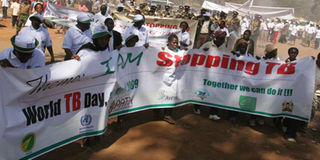Alarm as little progress made to stop killer TB

Kibera, Nairobi County, residents mark World TB Day on March 24, 2009. Global efforts to combat TB have saved an estimated 53 million lives since 2000. PHOTO | NATION MEDIA GROUP
What you need to know:
- According to the 2017 Global Tuberculosis Report, there were an estimated 10.4 million new TB cases worldwide in 2016.
- Multidrug-resistant TB (MDR-TB) remains a public health crisis and a health security threat.
Tuberculosis remained the number one infectious killer disease in 2016, a report has shown.
The disease was also the leading killer of people with HIV.
According to the 2017 Global Tuberculosis Report, there were an estimated 10.4 million new TB cases worldwide in 2016, 10 per cent of whom were people who had HIV.
FATALITIES
Seven countries accounted for 64 per cent of the total burden, with India bearing the brunt of the disease, followed by Indonesia, China, Philippines, Pakistan, Nigeria and South Africa.
According to the report, an estimated 1.7 million people died from TB, including nearly 400,000 who had HIV.
This is a drop by four per cent compared to 2015.
RESISTANCE
Multidrug-resistant TB (MDR-TB) remains a public health crisis and a health security threat, added the report.
The World Health Organization estimated that there were 600,000 new cases with resistance to rifampicin — the most effective first-line drug.
Of these cases, 490,000 had MDR-TB. Almost half of these cases were in India, China and Russia.
“The sheer number of deaths and suffering speak for themselves. We are not accelerating fast enough,” Dr Mario Raviglione, Director of the WHO Global TB Programme, said.
“Quick action towards universal health coverage and social protection, as well as breakthroughs in research and innovations will be critical to enable access to patient-centered care of the highest standards for all, especially the poorest, most disadvantaged people everywhere,” he added.
GLOBAL TARGETS
Global efforts to combat TB have, however, saved an estimated 53 million lives since 2000 and reduced the disease mortality rate by 37 per cent, the report showed.
Despite these achievements, progress in most countries was not fast enough to reach global targets or close persistent gaps in TB care and prevention, the report said.
WHO Director-General Tedros Adhanom Ghebreyesus said the first WHO Global Ministerial Conference to End TB in Moscow in 2017, followed by the first UN General Assembly High-Level Meeting on TB in 2018 were great opportunities to end the epidemic.
GOVERNMENTS
The conference in Moscow was aimed at increasing multisectoral action, motivate all sectors and secure attention at the highest levels.
The UN meeting will seek commitment from heads of state.
Already, 75 ministers from various countries have agreed to take urgent action to end TB by 2030.
“These will build momentum, get different sectors engaged, and accelerate our efforts to make TB history,” Dr Ghebreyesus added.
He said tackling the epidemic not only required action to close gaps in care and financing, but it also required progress in high TB burden countries.




